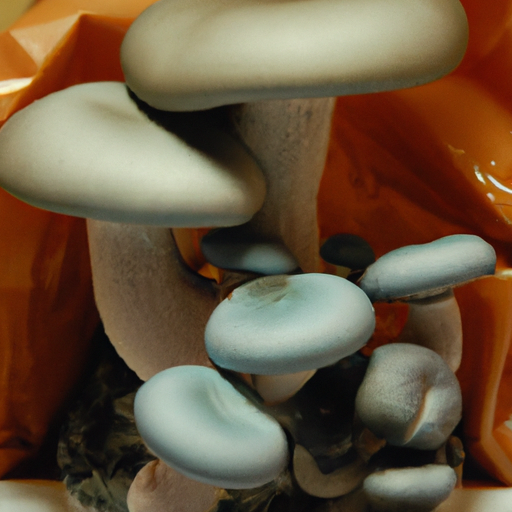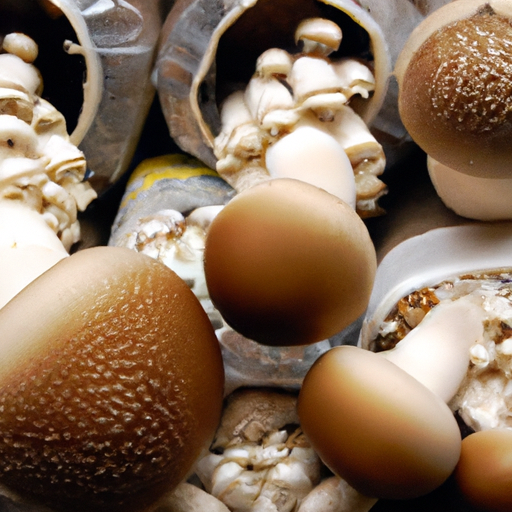In this article, you will discover the different types of mushrooms that you can easily grow right in your own home. We will explore a variety of options, from the classic button mushrooms to more exotic varieties like shiitake and oyster mushrooms. By the end, you will have a better understanding of which mushrooms are best suited for home cultivation and how to get started on your own mushroom-growing adventure. So, let’s dive in and explore the fascinating world of mushroom cultivation!

Introduction
If you’re interested in gardening and want to try something different, growing mushrooms at home can be a fascinating and rewarding experience. Not only are mushrooms a versatile ingredient in a variety of dishes, but they also offer numerous health benefits. Additionally, growing mushrooms at home can be a cost-effective and eco-friendly way to enjoy these nutritious fungi. In this article, we will explore the benefits of growing mushrooms at home, the different types of mushrooms you can grow, and how to cultivate and harvest them.
Benefits of Growing Mushrooms at Home
Health Benefits
Mushrooms are not only delicious but also packed with essential nutrients. They are a great source of protein and dietary fiber, while also being low in calories and fat. Mushrooms are also rich in vitamins like B complex vitamins, vitamin D, and minerals such as potassium, copper, and selenium. Incorporating mushrooms into your diet can boost your immune system, promote heart health and weight management, and reduce the risk of chronic diseases such as cancer and diabetes.
Cost Savings
Growing mushrooms at home can be a cost-effective alternative to constantly buying them from the store. Mushrooms are known for being quite expensive, and by cultivating your own supply, you can save money in the long run. While the initial setup may require some investment, the ongoing cost of growing mushrooms at home is relatively low. Plus, you’ll have the satisfaction of knowing that your mushrooms are organic and free from any harmful chemicals or pesticides.
Environmental Sustainability
Growing mushrooms at home is an environmentally sustainable practice. Unlike traditional gardening, mushrooms don’t require large amounts of space or soil. They can be grown indoors or in small outdoor spaces, which makes them suitable for urban dwellers with limited gardening opportunities. Additionally, mushrooms can be cultivated using various organic waste materials such as coffee grounds, sawdust, or straw. By repurposing these materials, you not only prevent them from ending up in landfills but also create nutrient-rich ecosystems for mushroom growth.
Choosing the Right Type of Mushroom to Grow
Before starting your mushroom cultivation journey, it’s important to understand the different types of mushrooms you can grow at home. There are two main categories of mushrooms: edible and medicinal.
Edible Mushrooms
Edible mushrooms are the most commonly cultivated mushrooms and are used in a wide range of culinary dishes due to their unique flavors and textures. Some popular edible mushrooms that you can grow at home include button mushrooms, shiitake mushrooms, oyster mushrooms, and portobello mushrooms.
Medicinal Mushrooms
Medicinal mushrooms, as the name suggests, have various health benefits and are commonly used in traditional medicine practices. These mushrooms are believed to have immune-boosting, anti-inflammatory, and antioxidant properties. Some popular medicinal mushrooms that you can grow at home include reishi mushrooms, lion’s mane mushrooms, and chaga mushrooms.
Edible Mushrooms
Button Mushrooms
Button mushrooms are one of the most widely consumed mushrooms around the world. They have a mild flavor and a firm, meaty texture, making them versatile for various culinary applications.
Shiitake Mushrooms
Shiitake mushrooms have a distinct umami flavor and are commonly used in East Asian cuisine. They have a chewy texture and are known for their medicinal properties.
Oyster Mushrooms
Oyster mushrooms have a delicate flavor and a soft, velvety texture. They are quick and easy to grow, making them a popular choice for mushroom cultivation beginners.
Portobello Mushrooms
Portobello mushrooms are actually matured cremini mushrooms. They have a meaty texture and a robust flavor, making them a popular choice for grilling or stuffing.

Button Mushrooms
Description and Characteristics
Button mushrooms, also known as white mushrooms or champignon mushrooms, are small to medium-sized mushrooms with a convex cap shape. They have a creamy white color and a mild, slightly earthy flavor.
Growing Requirements
Button mushrooms thrive in a temperature range of 55-65°F (13-18°C) and require a humid environment with good air circulation. They can be grown in a variety of growing mediums, such as compost, sterilized soil, or manure. The growing medium needs to be hydrated and kept at a pH of around 7.
Harvesting and Storage
Button mushrooms are typically ready to be harvested within 2-3 weeks of initial growth. They should be harvested when the caps have fully expanded but before the gills turn dark. To harvest, twist the mushrooms gently at the base to separate them from the substrate. Button mushrooms can be stored in a paper bag or wrapped in a damp cloth in the refrigerator for up to a week.
Shiitake Mushrooms
Description and Characteristics
Shiitake mushrooms have a unique appearance with a brown, umbrella-shaped cap and a white or tan-colored stem. They have a distinct savory, earthy flavor.
Growing Requirements
Shiitake mushrooms prefer a slightly warmer temperature range of 60-80°F (15-27°C). They can be grown on hardwood logs, sawdust, or a mixture of both. The growing medium should be sterilized before inoculating it with shiitake spawn. Shiitake mushrooms require a high humidity level of around 85-90%.
Harvesting and Storage
Shiitake mushrooms can be harvested when the caps flatten out and the edges begin to lift. Twist or cut the stems close to the growing substrate to harvest. Shiitake mushrooms can be stored in a paper bag in the refrigerator for up to two weeks. Alternatively, they can be dried for long-term storage.
Oyster Mushrooms
Description and Characteristics
Oyster mushrooms are named for their resemblance to oysters in appearance. They have a fan-shaped cap with a range of colors, including white, gray, pink, or yellow. Oyster mushrooms have a delicate flavor and a tender texture.
Growing Requirements
Oyster mushrooms are relatively easy to grow and can thrive in a temperature range of 60-75°F (15-24°C). They can be cultivated on a variety of substrates such as straw, sawdust, or coffee grounds. Oyster mushrooms require high humidity and good air circulation for optimal growth.
Harvesting and Storage
Oyster mushrooms can be harvested when the caps are fully opened. To harvest, twist or cut the mushrooms close to the substrate. Oyster mushrooms should be consumed or stored within a few days of harvesting as they have a shorter shelf life compared to other mushroom varieties. They can be stored in a paper bag in the refrigerator.
Portobello Mushrooms
Description and Characteristics
Portobello mushrooms are large, meaty mushrooms with a tan-colored cap and dark gills. They are the mature form of cremini mushrooms and have a rich, earthy flavor.
Growing Requirements
Portobello mushrooms require similar growing conditions as button mushrooms. They prefer a temperature range of 55-65°F (13-18°C) and a humid environment. The growing medium can be compost, sterilized soil, or manure. It should be kept moist and maintained at a pH of around 7.
Harvesting and Storage
Portobello mushrooms can be harvested when the caps have fully flattened and the gills underneath have separated. To harvest, gently twist or cut the mushrooms close to the substrate. Portobello mushrooms can be stored in a paper bag or wrapped in a damp cloth in the refrigerator for up to a week.
Medicinal Mushrooms
Reishi Mushrooms
Reishi mushrooms, also known as lingzhi mushrooms, are known for their medicinal properties. They have a woody texture and a bitter taste. Reishi mushrooms are believed to have immune-boosting, anti-inflammatory, and stress-reducing effects.
Lion’s Mane Mushrooms
Lion’s mane mushrooms have a unique appearance with long, spiky white or yellowish spines that resemble a lion’s mane. They have a mild, slightly sweet flavor and are known for their potential cognitive and nerve health benefits.
Chaga Mushrooms
Chaga mushrooms have a rough, black exterior and a vibrant orange-brown interior. They grow on birch trees and are known for their antioxidant and immune-boosting properties. Chaga mushrooms are typically consumed in the form of tea or extracts.
Conclusion
Growing mushrooms at home can be a fun and fulfilling hobby that allows you to enjoy the unique flavors and health benefits of fresh mushrooms. By choosing the right type of mushrooms and providing the optimal growing conditions, you can cultivate a bountiful harvest right in your own home. Whether you’re interested in growing edible mushrooms for culinary purposes or medicinal mushrooms for their potential health benefits, the possibilities are endless. So why not give it a try and embark on your own mushroom cultivation journey? Happy growing!



No Responses